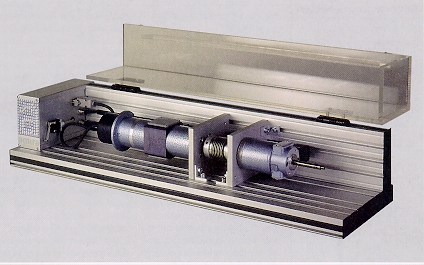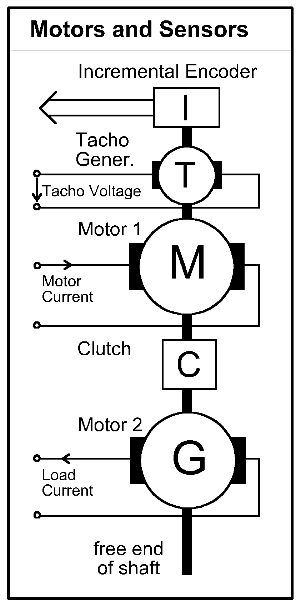

Brief Description:
Laboratory experiment DR300 Speed Control with Variable Load
| The laboratory experimental setup "Speed
Control with Variable Load" contains the technical realization of a nonlinear
single-input/single-output system with appropriate actuator, sensors, measurement outputs
and the possibility to connect different controllers. The plant is represented by a permanently exited DC-motor (M1) of which the input signal (armature current) is provided by a current control loop. Its servo amplifier allows the 4 quadrant mode. The sensors for the output signal (speed) are a tacho generator (T) and an incremental encoder (I). The free end oft the motor shaft is fixedly coupled (K) to the shaft of a second, identical motor (M2). This motor is used as a generator. Its output current is freely adjustable. The second end of the generator shaft provides the possibility to mount an additional mass.  The motors are mounted on top of aluminium profiles. The system is ready to operate and is plugged to the appropriate electronics using only one connector. The motors and all of the rotating parts are protected by a transparent plexiglass cover which lets down. In the standard version the system DR300 consists of the mechanical setup and a 19" case. It contains the servo amplifiers, built by current controllers, for the motor and the generator, the signal adaption unit, power supplies and a module with measurement outputs. A detailed documentation is included. The option 300-01 extends the system by an analog PI-controller which is integrated in the case. The speed setpoint of the motor and the load current of the generator are adjustable by providing DC voltage in the range +/-10 Volt to BNC jackets. The measurement signal for the controller is provided by the tacho generator. The proportional and integral portion of the controller can be adjusted by coefficient potentiometers. |
The option 300-02 extends the standard version of the
DR300 by an additional card for an IBM-AT compatible PC. It contains A/D-D/A converters,
digital input/output channels and an incremental encoder input channel. The included
practical experiment "PI Speed Control" deals with parameter settings for
PI-controllers using Bode diagrams and optimal compensation methods with respect to the
plant parameters which are determined during the experiment. The PC program is controlled
by pull down menus which are activated by a mouse and/or by keyboard (Turbo-Vision desktop
of Borland). It allows a comfortable identification of the plant parameters using the
recorded step responses of the open control loop. A PI-controller is implemented to
control the system. Its parameters can be changed online. The control performance with
respect to reference and disturbance behaviour can be examined by recording the system
response after variations in the reference and the disturbance signals. The input signals
are adjustable with periodical behaviour. Graphic output of the recorded signals to the
monitor of the PC, to an HP-compatible plotter or an Epson-compatible printer provides the
evaluation of the results. The program allows to store the adjusted or measured plant and
controller parameters to an ASCII file. Those data can be load later on. The option 300-03 extends the program described under option 300-02 by a Fuzzy-controller. The practical experiment "Fuzzy Speed Control" explains the concept of a Fuzzy-control. It can be used as an extension to the practical experiment "PI Speed Control". An ASCII file is used to define any fuzzy set and rule. A second, virtual input signal, the angular acceleration, is computed from the angular velocity of the motor. The comparison of Fuzzy-control and PI-control can be easily performed by switching the controller mode. The option 300-04 extends the system by an electrical disturbance module which is mounted in the 19"-case. Its front panel contains switches and potentiometers to simulate failures. The manipulated signals are the tacho generator signal and the control signal for the servo amplifier of the motor. Both signals can be scaled or switched off. The option 300-05 consists of the C++- source code with documentation of the program mentioned under opt. 300-03 including libraries for the graphic output and the fuzzy operations . It is useful for software extensions to study for instance position control, model based failure detection, comparison of tacho generators versus incremental encoders etc. The Borland C++ compiler with the Turbo-Vision library is required to generate an executable program. Technical data are subject to change (Date 22-February-1996) |